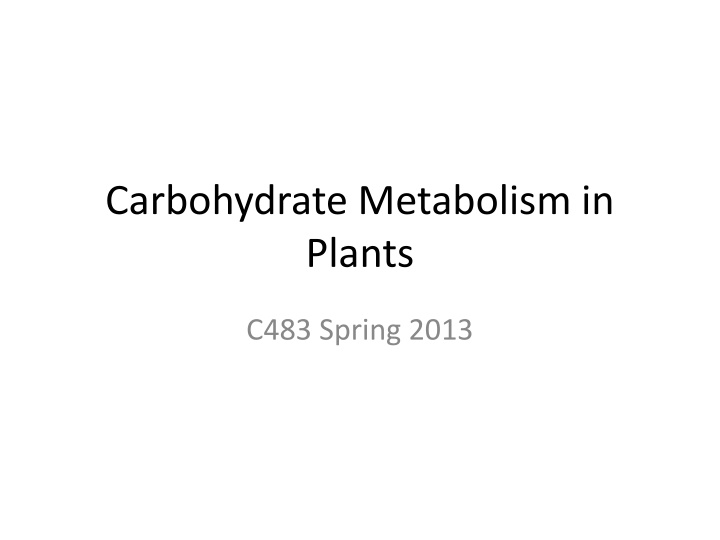
Carbohydrate Metabolism in Plants: Calvin Cycle and Dark Reactions Explained
Explore the intricacies of carbohydrate metabolism in plants, delving into the Calvin cycle, CO2 fixation, and the dark reactions of photosynthesis. Learn about key molecules, ATP requirements, sucrose biosynthesis, and more in this comprehensive study of plant metabolism processes.
Uploaded on | 0 Views
Download Presentation

Please find below an Image/Link to download the presentation.
The content on the website is provided AS IS for your information and personal use only. It may not be sold, licensed, or shared on other websites without obtaining consent from the author. If you encounter any issues during the download, it is possible that the publisher has removed the file from their server.
You are allowed to download the files provided on this website for personal or commercial use, subject to the condition that they are used lawfully. All files are the property of their respective owners.
The content on the website is provided AS IS for your information and personal use only. It may not be sold, licensed, or shared on other websites without obtaining consent from the author.
E N D
Presentation Transcript
Carbohydrate Metabolism in Plants C483 Spring 2013
1. Which molecule is the CO2 acceptor in the first step of the Calvin cycle? A) Rubisco. B) Ribulose 1,5-bisphosphate. C) 3-phosphoglycerate. D) Glyceraldehyde-3-phosphate. 2. How many ATP molecules are required for the fixation of one CO2 molecule via the Calvin cycle to a triose phosphate? A) 3 B) 6 C) 9 D) 12 3. Starting with carbon dioxide fixation, which is the correct order for the stages of the Calvin cycle? A) Carboxylation Reduction Regeneration. B) Regeneration Carboxylation Reduction. C) Carboxylation Regeneration Reduction. D) Reduction Carboxylation Regeneration.
4. Which is not an intermediate in the biosynthesis of sucrose in plants? A) ADP-glucose. B) Glucose 6-phosphate. C) Fructose 6-phosphate. D) UDP-glucose 5. Which of the following plant carbohydrate metabolism reactions will happen in the dark? A) Carbon dioxide fixation B) Formation of starch from glucose C) Formation of glucose from sucrose D) Conversion of 3C sugars to 5C sugars
Dark Reactions Photosynthesis can be split into two parts Light reactions: light ATP + NADPH Dark Reactions: CO2 + ATP +NADPH carbs Overall: light + CO2 carbohydrates Dark reactions don t happen in dark; they do not directly require light
Calvin Cycle Fixing CO2 (carboxylation) Reductive synthesis of carbohydrates Regeneration of cycle
1. Carboxylation: Rubisco Carboxylation of Ribulose Production of 3- phosphoglycerate Not an efficient enzyme Inactive in dark (when there is no proton gradient, pH changes conformation)
Take home: 5C + CO2 two 3C Not useful yet where does ribulose come from? And 3-phosphoglycerate is not a fuel yet.
2. Reductive Stage Major expenditure of ATP and NADPH Now in the oxidation state to make storable fuel Still a problem: where did ribulose come from? From here, we see gluconeogenesis
3. Regeneration Stage Take some of the 3- carbon sugars and remake ribulose Regeneration of 5C sugars, but also a net formation of 3 carbon sugars. Consider Start with 3 ribulose and 3 CO2, you will make six 3-carbon sugars
Net Reaction The net reaction of al three stages looks simple But is quite complex stepwise
Photorespiration Rubisco has a wasteful side reaction Fixes oxygen For every two ribulose destroyed, 9 carbons can be salvaged
Carbohydrate Storage and Utilization Why do plants make glucose and carbs? Structural polymers Storage of fuel Starch Sucrose Plants need to live in the dark and in winter! Plants have cells that are not photosynthetic
Starch Similar to glycogen synthesis, but ADP- glucose is intermediate Synthesized in light, Utilized in the dark
Sucrose Mobile fuel source (blood sugar for plants)
Answers 1. B 2. A 3. A 4. A 5. C
